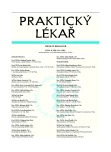Physical activity as a part of cardiovascular disease prevention in the general practitioner’s surgery
Authors:
D. Pastucha 1; E. Sovová 1; J. Malinčíková 1; R. Tichá 1; V. Talafa 2; Marek Sova 3
Authors‘ workplace:
Klinika tělovýchovného lékařství a kardiovaskulární rehabilitace FN a LF UP v Olomouci
Přednostka: doc. MUDr. Eliška Sovová, Ph. D, MBA
1; Interní oddělení, Nemocnice Frýdek-Místek
Primář: MUDr. Petr Vítek
2; Lékařská fakulta UP v Olomouci
Děkan: prof. MUDr. Zdeněk Kolář, CSc.
3
Published in:
Prakt. Lék. 2010; 90(8): 466-469
Category:
Of different specialties
Overview
Physical activity plays a crucial role in the primary as well as secondary prevention and treatment of cardiovascular disease (CVD) and risk factors associated with this disorder. As primary prevention, physical activity in asymptomatic individuals acts to protect against the development of lifestyle diseases. These include hypertension, obesity, insulin resistance, diabetes mellitus and hyperlipidemia. In both primary and secondary prevention, physical activity is an integral part of treatment of patients with cardiovascular diseases such as
- ischemic heart disease,
- peripheral vascular disease, and
- heart failure.
Intensive co-operation between various medical fields has contributed to a reduction of CVD morbidity and mortality in the Czech Republic over the last five years. However, CVD still remains the most common cause of death in adults. It is responsible for the majority of employment disability and every year considerable financial resources are spent on its treatment. Furthermore CVD is responsible for more than 50 % of all general admissions in hospital departments and it continues to represent a substantial health and socio-economic problem. Despite the fact that physical activity is inexpensive, efficient and, when following guidelines, a safe way to influence modifiable risk factors such as being overweight, hypertension, dyslipidemia and insulin resistance, the physical activity of the Czech population is still inadequate.
General practitioners need to be continuously dedicated to increasing patient compliance, for example by monitoring physical activity.
Key words:
physical activity, physical activity monitoring, cardiovascular prevention
Sources
1. Craig, C.L., Marshall, A.L., Sjöström, M. et al. International physical activity questionnaire: 12-country reliability and validity. Med. Sci. Sports. Exerc. 2003, 35(8), p. 1381-1395.
2. Cuberek, R., Skalik, K., Frömel, K. Komparace individuální kategorizace úrovně pohybové aktivity monitorované akcelerometrem a krokoměrem. Česká kiantropologie 2009, 13(4), s. 9-15.
3. EU Sport Ministers (2008). EU physical activity guidelines. Recommended policy actions in support of health-enhancing physical activity. [cit. 17. 6. 2010] Dostupný na: http://ec.europa.eu/sport/library/doc/c1/pa_guidelines_4th_consolidated_draft_en.pdf
4. Frömel, K., Baumann, A., Bláha, L. a kol. Intenzita a objem pohybové aktivity 15-69 leté populace České republiky. Česká kiantropologie 2006, 10(1), s. 13-27.
5. Hatano, Y. Use of the pedometer for promoting daily walking exercise. ICHPER 1993, 29, p. 4-8.
6. Haskell, W.L., Lee, I.M., Pate, R.R. et al. Physical activity and public health: updated recommendation for adults from the American College of Sports Medicine and the American Heart Association. Med. Sci. Sports. Exerc. 2007, 39(8), p. 1423-1434.
7. Kočová, R. Životní styl obyvatel České republiky. Tím, jak žijeme, ovlivňujeme i své zdraví. Zdrav. ČR 1999, 2(1), s. 23-26.
8. Le Masurier, G.C., Lee, S.M., Tudor-Locke, C. Motion sensor accuracy under controlled and free-living conditions. Med. Sci. Sports. Exerc. 2004, 36(5), p. 905-910.
9. Máček, M., Máčková, J. Počet kroků jako ukazatel tělesné zdatnosti. Med. Sport. Boh. Slov. 2010, 19(2), s. 115-121.
10. Mayer, O. jr., Cífková, R.2, Filipovský, J. a kol. Prevalence asymptomaticky vysokého rizika kardiovaskulárních chorob ve vzorku obecné české populace a adherence k doporučeným cílovým hodnotám primární prevence. Prakt. Lék., 2010, 90(4), s. 230-234.
11. Němcová, H. Pohybová aktivita v prevenci civilizačních chorob - doporučené postupy pro praktické lékaře. [cit. 17.6. 2010]. Dostupný na : www.cls.cz/dokumenty2/postupy/t253.rtf
12. Pelclová, J., Gába, A., Přidalová, M. a kol. Vztah mezi doporučeními vztahujícími se k množství pohybové aktivity a vybranými ukazateli zdraví u žen navštěvujících univerzitu třetího věku. Tělesná kultura 2009, 32(2), s. 64.-78.
13. Pelclová, J., Vašíčková, J., Frömel, K. a kol. Vliv demografických faktorů na pohybovou aktivitu a sezení u obyvatel české republiky ve věku 55-69 let. Tělesná kultura 2008, 31(2), s. 109-119.
14. Pelclová, J., Vašíčková, J., Frömel, K. a kol. Vliv vybraných faktorů na pohybovou aktivitu a sezení u zaměstnaných a osob v důchodu ve věku 55-69 let. Tělesná kultura 2008, 12(4), s. 49-59.
15. Placheta, Z., Sieglová, J., Štejfa M. Zátěžová diagnostika v ambulantní a klinické praxi. 1. vyd. Praha: Grada Publishing, 1999. 276 s. ISBN 80-7169-271-9.
16. Rybka, J. Fyzická aktivita (zátěž) – jeden z pilířů prevence a terapie diabetes mellitus. Interní Med. 2005, 3, s. 135–138.
17. Stejskal, P. Proč a jak se zdravě hýbat. 1. vyd. Břeclav: Presstempus, 2004. 125 s. ISBN 80-903350-2-0.
18. Svačinová, H. Role pohybové léčby v prevenci a léčbě metabolického syndromu. Vnitř. Lék. 2005, 51, s. 23–28.
19. Tudor-Locke, C., Hart, T.L., Washington, T.L. Expected values for pedometer-determined physical activity in older populations. Int. J. Behav. Nutr. Phys. Act. 2009, 25, p. 6-59.
20. United States Department of Health and Human Services (USDHHS). Healthy people 2010: Understanding and improving health. 2nd ed. Washington, DC: U.S. Government Printing Office, 2000.
21. Vašíčková, J., Pelclová, J., Frömel, K. a kol. Pilotní studie ročního režimu pohybové aktivity gymnaziálních studentek. Tělesná kultura, 2008, 31(2), s. 102-108.
22. Vilkus, Z. Pohybová aktivita u dětí s nadměrnou hmotností a obezitou. In Vignerová, J. a kol. Sledování růstu českých dětí a dospívajících. Norma, vyhublost, obezita. Praha: Státní zdravotní ústav, 2001, s. 148-151.
23. WHO (2009). Why move for health. [cit. 17. 6. 2010]. Dostupný na: http://www.who.int/moveforhealth/en/
Labels
General practitioner for children and adolescents General practitioner for adultsArticle was published in
General Practitioner

2010 Issue 8
Most read in this issue
- Spontaneous intracranial hypotension
- Zinc and its relation to prostate tumours
- Human biomonitoring – its importance and application for evaluating population exposure to environmental chemicals (toxins)
- Physical activity as a part of cardiovascular disease prevention in the general practitioner’s surgery
